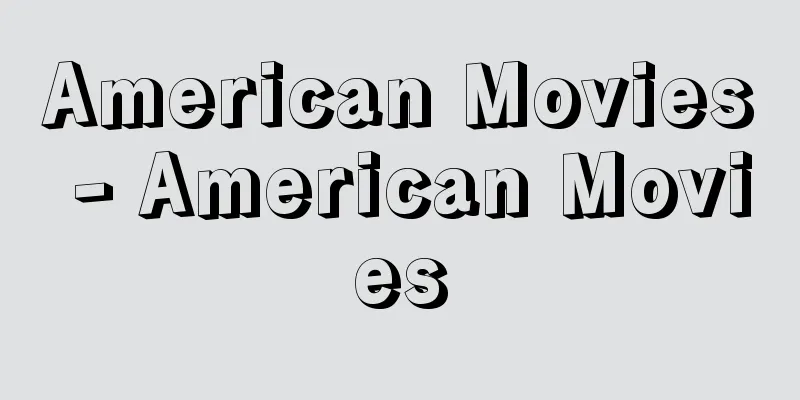American Movies - American Movies

|
The precursor to today's film-based movies was invented in the United States. It was the "Kinetoscope," a moving-picture machine that Thomas Edison ordered from George Eastman, founder of what was then the world's largest film company, in 1889. However, this was a "peep-glasses" type machine that could only be viewed by one person at a time, and it was commonly called a "peep show." It was popular when placed in public entertainment venues and bars. [Yukichi Shinada] The birth of American cinemaThe method of projecting an enlarged image onto a screen, as we do today, began with Edison's Vitascope, which was shown on Broadway in New York in 1896. This was the official birth of American cinema (the French Lumiere brothers' Cinematograph was shown in Paris the year before, in 1895). Early films were single rolls of about 15 to 30 meters long, and were shown at theaters commonly known as nickelodeons (meaning five-cent theaters), and were very popular among the general public. Production companies were established one after another in eastern cities, centered around New York, and Jewish people were particularly active in this new business, hoping to make a fortune. At first, there were many childish live-action films and skits, and people were attracted above all by the novelty of the projected objects moving. As technology improved, screening times became longer and more ingenious expressions were put into them. In his film Life of an American Fireman (1902), Edwin S. Porter invented the method of "editing" by connecting and combining different shots, and in his follow-up, The Great Train Robbery (1903), he pioneered dramatic expression by creating the close-up shot. [Yukichi Shinada] The Development of HollywoodCalifornia, a western region with little rain, was considered ideal for filming movies, and many film studios were built in Hollywood, a suburb of Los Angeles, in the years from 1911. However, this was not simply because of the favorable climate and geographical conditions, but also because film companies in the east formed trusts using film patents as a shield and imposed harsh conditions on newcomers, so the west was chosen because the trusts' supervision was less likely to reach them. Thus began the development of Hollywood, known as the "factory of dreams," and the name Hollywood became synonymous with American movies. It was also during this period that the so-called star system, a way of making movies that makes the most of the popularity of the actors who star in them, began. The most notable work in terms of films is the work of David Walker Griffith, who invented techniques of cut-backs, fade-outs, and fade-ins that later became the basis of film grammar in his first American feature films, The Birth of a Nation (1915) and Intolerance (1916). World War I caused a stagnation in the European film industry, but the American film industry, which was not directly affected by the war, developed greatly, and Westerns, slapstick comedies, and serials were actively produced. Then, from the end of the war to the late 1920s, silent films entered their golden age. Charles Chaplin, a former British vaudeville performer who rose to prominence in slapstick comedy with his unique costumes, also directed classics such as The Gold Rush (1925), and Buster Keaton and Harold Lloyd also marked an era as comedy stars. Other notable Western frontier films include James Cruze's (1884-1942) Wagon (1923) and John Ford's The Iron Horse (1924). It was during this period that the foundations of the so-called "major companies" that form the core of today's American film, such as Paramount, MGM, Warner Brothers, Universal, Fox, and Columbia, were established. As the American film industry continued to develop and expand, it actively invited outstanding directors and actors from European films, further diversifying its activities. Directors such as Erich von Stroheim, Ernst Lubitsch, Friedrich Wilhelm Murnau, Victor Sjöström, Maurits Stierler, and Josef von Sternberg, as well as actors and actresses such as Greta Garbo and Marlene Dietrich, enriched the international character of American films. [Yukichi Shinada] The Establishment of the American Film IndustryThe era of talkies began with the sound version of Don Juan (1926) with accompanying music, and The Jazz Singer (1927) with simultaneous recording of music and dance scenes. The acquisition of sound, which had previously appealed only to the visual sense, was a groundbreaking technological innovation. Thanks to this, movies were not significantly affected by the economic depression that hit America in 1929, and encouraged large capital to enter the "recession-proof" movie industry. On the other hand, film capital also needed large capital investments in equipment to make talkies, and they had to rely on the entry of large capital. While European movies cultivated a tradition of artisticism, American movies placed emphasis on entertainment from the beginning. With sound and strong capital, American movies spread their roots as the most influential form of popular culture, and at the same time developed into an extremely large industry. In the early days of talkies, there was a strong tendency to imitate stage plays because there was no established methodology, but gradually, unique film formats such as music films, westerns, gangster action films, war action films, realistic films, and cartoon films were established. Representative works from this period include Lewis Milestone's All Quiet on the Western Front (1930), Josef von Sternberg's Morocco (1930), Frank Capra's It Happened One Night (1934), William Wyler's Mrs. Peacock (1936), and John Ford's Stagecoach (1939). The culmination of American films from this period can be considered to be two films: Gone with the Wind (1939), which can be said to be the pinnacle of Hollywood blockbusterism, and Citizen Kane (1941), directed and starring Orson Welles, which can be said to be the quintessence of American film artistry. During the silent film era, American movies produced popular stars such as Mary Pickford, Douglas Fairbanks, Rudolph Valentino, and Gloria Swanson. In the talkie era, American movies produced big stars such as Gary Cooper, Clark Gable, Greta Garbo, Marlene Dietrich, Claudette Colbert, Barbara Stanwyck (1907-1990), Joan Crawford, and Bette Davis. The star system of American movies was at its most glamorous from the 1930s to the 1940s. With the shift to talkies, many stars came from the theater world to the film world, such as Humphrey Bogart and Henry Fonda. On the other hand, some stars from the silent era fell behind because they had bad voices or couldn't deliver their lines. [Yukichi Shinada] Post-World War II boomDuring World War II, the American film industry fully cooperated with the national policy, producing many films to boost morale and entertainment for wartime citizens and soldiers. In addition, European filmmakers who did not sympathize with Nazism, such as Rene Clair, Jean Renoir, Julien Duvivier, and Jean Gabin, fled to America to work in the film industry. After World War II, American movies continued to mass-produce entertaining works as before, but realistic works began to stand out, reflecting the harsh experiences of war. Films such as Billy Wilder's The Lost Weekend (1945) and Sunset Boulevard (1950), who fled the Nazis to America, Wyler's The Best Years of Our Lives (1946), Joseph L. Mankiewicz's Letter to Three Wives (1949) and All About Eve (1950), John Huston's The Gold (1948), and Elia Kazan's On the Waterfront (1954) all reflected the reality of America in their own way, and Hollywood movies, which were once called the "factory of dreams" and always preached happy endings, gradually began to change. John Ford's western, My Darling Clementine (1946), is a masterpiece that depicts the simple sense of justice and heroism of the good old days, but even westerns, which can be said to be the essence of American cinema, gradually began to take on an iconoclastic tendency in the 1950s. The big problem that American movies faced in the 1950s was how to respond to the sudden rise of television. The movie industry tried to maintain the superiority of movies by surpassing the small screen of television with 3D movies and "Cinerama," which projected three films side by side. In 1953, the "Cinemascope" method, which uses distortion lenses to create a large horizontal screen, was put into practical use, and the era of large-screen movies began. Color movies, which had been made sporadically since the early 1930s, also rapidly spread during this period. Of course, this was to overcome television, which still had a black-and-white screen. In the 1960s, 70mm movies, which doubled the width of conventional film, were put into practical use, and movies became even more impressive with their large screens. Robert Wise's "West Side Story" (1961) and David Lean's "Lawrence of Arabia" (1962) are representative early works. Furthermore, the development of surround sound and other technologies further amplified the spectacular nature of the event. [Yukichi Shinada] The new wave of American cinemaThis trend encouraged a trend towards blockbusters, and in order to curb the associated inflation in production costs, American films were increasingly produced in Italy, Spain, and other countries. Meanwhile, filmmakers from television began to branch out into film, and the so-called "New York School" of filmmakers, such as Sidney Lumet of 12 Angry Men (1957) and John Frankenheimer of Criminal Justice (1962), became prominent. The 1950s and 1960s were a time when the filmmaking system centered on Hollywood studios was gradually disintegrating. In 1967, Arthur Penn, who had been a TV and stage actor, released "Tomorrow is Just Another Day," followed by "Easy Rider" (1969) directed by actor Dennis Hopper, and the era of "New Cinema" began. This was a kind of rebellion against the traditional Hollywood method, breathing fresh air into film by focusing on realistic expression rather than fictional drama, filming on location, and anti-establishment themes. However, this trend had the negative effect of producing immature and self-centered works, and the content, which was too directly reflective of reality, ended up alienating audiences who sought dreams and relaxation in films. A new generation of directors who emerged in the 1970s, including Francis Ford Coppola, Steven Spielberg, and George Lucas, achieved box office success and high acclaim with films such as The Godfather (1972), Jaws (1975), and Star Wars (1977), respectively. What distinguishes them is that they attempted to further develop the possibilities for new cinematic expression pioneered by New Cinema, while still respecting the inherent entertainment value of film. Along with these changes in the movies themselves, the star system, which was the front line of American movies, also underwent a major transformation. The era of beautiful men and women came to an end in the 1940s, and rather than the beautiful men and women types such as Robert Taylor (1911-1969) and Elizabeth Taylor, an era of unique stars such as Marlon Brando, James Dean, and Audrey Hepburn began. Marilyn Monroe could be said to be the last glamour star of Hollywood. [Yukichi Shinada] current situationToday, the days of drawing audiences with star value are almost completely gone. However, there are still stars like Sylvester Stallone (1946- ), who sold his own screenplay, Rocky, to a major company and starred in the film adaptation (1976), which was a huge success. The media called him the embodiment of the American Dream. Spielberg, who had a commercial success with Jaws, also became the most commercially successful director of the action film Indiana Jones series (1981-1989), science fiction film ET (1982), and Jurassic Park (1993), and further won the long-awaited Academy Award for Best Picture and Best Director for Schindler's List (1993), which was set in a Nazi concentration camp. He then became one of the founders of the film production company DreamWorks and rose to become a central figure in the American film industry. George Lucas, who has followed a similar path, not only worked on the Star Wars sequels but also founded the special effects production company ILM (Industrial Light & Magic), becoming a major presence in the special effects world of American films. Oliver Stone, who was active as a screenwriter with works such as "Midnight Express" (1978), won the Academy Award for Best Director in 1986 for "Platoon," which realistically exposed the reality of the Vietnam War. Since then, he has released many political films critical of the system, such as "Born on the Fourth of July" (1989), "JFK" (1991), and "Nixon" (1995). Popular star Kevin Costner (1955- ) starred in and directed the Western masterpiece "Dances with Wolves" (1990), for which he won the Academy Award for Best Picture and Best Director. This drama about a cavalry officer who becomes close with Native Americans raises themes such as affinity with nature and doubts about the military conquest of white people, making it a work with a completely different content from conventional Westerns. Another popular star turned director, Clint Eastwood, starred in and directed Unforgiven, which won the Academy Award for Best Picture and Best Director in 1992. It can be said that the film is permeated with the atonement associated with the Western frontier. Eastwood won the Academy Award for Best Picture and Best Director again in 2004 for Million Dollar Baby, and has now become a representative director of American films. In 2006, Eastwood directed a two-part film about the Battle of Iwo Jima, where the Japanese army was almost completely annihilated in World War II, Flags of Our Fathers, which tells the story from the American side, and Letters from Iwo Jima, which tells the story from the Japanese side, approaching the truth of the Battle of Iwo Jima. Of these, Letters from Iwo Jima, which was told from the Japanese side, was an unusual and controversial film, as most of the actors were Japanese and most of the dialogue was in Japanese, despite being an American film. Major works from the 1990s include Spielberg's Schindler's List, Robert Altman's Short Cuts (1993), Robert Zemeckis' Forrest Gump (1994), Quentin Tarantino's Pulp Fiction (1994), Frank Darabont's (1959- ) The Shawshank Redemption (1994), Ron Howard's (1954- ) Apollo 13 (1995), and Joel Coen's (1954- ) Fargo (1996), and a wide variety of works were produced, ranging from serious problem-raising works to entertainment blockbusters. Younger talent also emerged, as seen in Gus Van Sant's (1952- ) Good Will Hunting (1997), written by and starring Ben Affleck (1972- ) and Matt Damon (1970- ). The 1990s saw the birth of ambitious works such as those mentioned above, and saw the worldwide smash hit Titanic (1997) by James Cameron, which won the Academy Award for Best Picture and Best Director, and the film transitioned into an era of spectacular blockbusters that made effective use of computer graphics. Representative works from this era include Gladiator, which won the Academy Award for Best Picture in 2000, and The Lord of the Rings: The Return of the King, which won the Academy Award for Best Picture in 2003. What these works show is the fact that talents from English-speaking countries such as the United States, the United Kingdom, Canada, Australia, and New Zealand are becoming active in the world of American films. British films, which have been closely involved in the production of American films for a long time, are further deepening their ties, including in terms of production staff and actors. Ridley Scott, the director of Gladiator, is from the United Kingdom, Peter Jackson (1961- ), the director of the Lord of the Rings series (2001-2003), is from New Zealand, and James Cameron, director of Titanic, is from Canada. Many actors are also from the United Kingdom, Australia, and New Zealand, including Nicole Kidman (1967- ), Kate Winslet (1975- ), Cate Blanchett (1969- ), and Russell Crowe (1964- ). Another trend that must be mentioned is the proliferation of film series and remakes, which clearly indicates the weakening of planning ability in American films. Today, American films have come to have large markets not only in movie theaters, but also in the video, DVD, and cable television industries, and they also boast an overwhelming dominance in the film markets in Europe and Asia. The greatest strength of American films is their foundation in producing highly entertaining blockbusters with huge production costs. This has led to the creation of sci-fi action blockbusters such as "Star Wars," which made the most of special effects, and with the development of computer graphics, special effects have advanced even further. "Jurassic Park" recreated a herd of dinosaurs that do not exist in reality. We now live in an age where there is nothing that cannot be visually expressed in movies. In the 2000s, when digital technology such as computer graphics (CG) was introduced into the production field and there was nothing that could not be expressed visually, American movies released one blockbuster after another that made the most of this technology, increasing their presence in the global market. While there is criticism that the planning ability of American movies is weakening, many of these blockbusters are made into series, and there is a tendency for the figures to increase on a global scale with each successive release. Examples of this include the aforementioned Lord of the Rings series (2001-2003), as well as eight Harry Potter films (2001-2011), five Pirates of the Caribbean films (2003-2017), five Transformers films (2007-2017), three Spider-Man films (2002-2007), three Batman films (2005-2012), four Shrek films (2001-2010), and five Ice Age films (2002-2016). Furthermore, digital technology has led to the birth of new 3D movies. As mentioned above, 3D movies, or stereoscopic movies, were introduced in the 1950s as a response to television, but in the 2000s, the motivation for providing a unique movie theater experience remains the same (and this time, there is also the aspect of combating piracy). As 3D movies have not yet taken root in movie theaters, many industry professionals and audiences have been skeptical of them, but the huge success of "Avatar" (2009) completely changed the opinion. This film by director James Cameron broke the box office record of his own "Titanic," which had not been broken until then, and has promoted the digitalization of movie theaters worldwide so that new 3D movies can be screened. It will be interesting to see how the digitalization of both production and screening will change American films in the future, because American trends will ultimately lead the world's film scene. [Yukichi Shinada and Koichi Hamaguchi] "World Filmmakers 28: American Film History" by Hasumi Arihiro (1985, Kinema Junposha)" ▽ "100 Years of Hollywood" by Mizuno Haruo (1990, Keibunsha)" ▽ "American Film" by Sato Tadao (1990, Daisanbunmeisha)" ▽ "Digital Hollywood: Film Business in the Age of Multimedia" by Yasuki Masami (1995, Nihon Keizai Shimbun)" ▽ "Film Genre Theory: Hollywood Style of Pleasure" by Kato Mikio (1996, Heibonsha) " ▽ "Film: Politics of the Gaze: The Battle of Classical Hollywood Film" by Kato Mikio (1996, Chikuma Shobo)" ▽ "The Complete History of World Film 7, 8: The Blossoming of Silent Film Art: American Film's Conquest of the World 1, 2" by Georges Sadoul, translated by Maruo Sadao, Murayama Kyoichiro, Deguchi Taketo, and Komatsu Hiroshi (1997, Kokusho Kankokai) ▽ Kazuma Inoue, The Great American Film Textbook, Volumes 1 and 2 (1998, Shincho Sensho) ▽ Harumi Yahiro, Learning American Culture through Films: Understanding America by Watching Films (1999, Screenplay Publishing) ▽ Georges Sadoul, World Cinema History 11: The Maturity of Silent Film Art: The Establishment of Hollywood, translated by Sadao Maruo (1999, Kokusho Kankokai) ▽ Susumu Takiyama, Hollywood: The Global Strategy of the Massive Media (2000, Nihon Keizai Shimbun) ▽ Teruo Hata, ed., Encyclopedia of 20th Century American Films: Records of Films Released in Japan 1914→2000, 2 volumes (2002, Catalog House) ▽ Masaaki Oba, ed., American Filmism: Another USA (2002, Film Art) ▽ Eiji Tanaka, Contemporary American Films (2004, Kawade Shobo Shinsha) "America in the Movies" by Fujiwara Kiichi (2006, Asahi Sensho) ▽ "The 100-Year American Film Empire: Why Did American Films Dominate the World?" by Kitajima Akihiro (2008, Kindai Eigasha) ▽ "Cinema and Gender: Sex and War in American Film" by Tsukada Yukimitsu (2016, Rinsen Shoten) ▽ "Red Purge Hollywood: Biographies of Blacklisted Filmmakers Who Challenged the Red Scare Regime" by Uejima Haruhiko (2016, Sakuhinsha) ▽ "Directors of Contemporary American Films" by Tayama Rikiya (Gendai Kyoyo Bunko) ▽ "A Cultural History of American Film: America Created by Film, Volumes 1 and 2, by Robert Schoolar, translated by Suzuki Kazue (Kodansha Academic Library)" ▽ "Black Movies: American Films and Black Society" by Inoue Kazuma (Kodansha Gendai Shinsho) "Kitano Keisuke's 'Lectures on the 100-Year History of Hollywood: From the Factory of Dreams to the Kingdom of Dreams' (Heibonsha Shinsho)" ▽ "Midori Mall's 'Hollywood Business' (Bunshun Shinsho)" ▽ "Nakajo Shohei's 'Clint Eastwood: The Man Who Revived American Film History' (Chikuma Bunko)" [References] | | | | | | | | | | | | | | | | | | | | | | | | | | | | | | | wars| | | | | | | | | | | | | | |hollywood| | | | | | | | | | | | | | | | | | | | | | | | | | | |Source: Shogakukan Encyclopedia Nipponica About Encyclopedia Nipponica Information | Legend |
|
フィルムを用いる今日の映画の前身は、アメリカにおいて発明された。エジソンが1889年、当時世界一といわれるフィルム会社の創立者ジョージ・イーストマンに注文してつくらせた活動写真機械「キネトスコープ」がそれである。ただし、これは一度に1人しか見ることのできない「のぞき眼鏡」式のもので、一般には「ピープ・ショー」とよばれ、大衆娯楽場や酒場などに置かれて人気があった。 [品田雄吉] アメリカ映画の誕生現在と同じように、映像がスクリーンに拡大映写される方式は、1896年にニューヨークのブロードウェーで公開された、エジソンの「バイタスコープ」から始まった。これがアメリカ映画の正式の誕生である(フランスのリュミエール兄弟のシネマトグラフがパリで公開されたのはその前年の1895年)。初期の映画は15~30メートル程度の一巻物で、ニッケル・オデオン(5セント劇場の意)と俗称される興行場で上映され、庶民層に大きな人気を得た。ニューヨークを中心とする東部の諸都市に製作会社が続々と生まれたが、とくにこの新しいビジネスに一攫千金(いっかくせんきん)を賭(か)けるユダヤ系の進出が活発だった。当初は幼稚な実写や寸劇のたぐいが多く、なによりも映写されたものが動くことの新奇さに、人々はひかれた。技術が進歩するとともに、上映時間も長くなり、表現にもくふうがこらされるようになった。エドウィン・S・ポーターは『アメリカ消防夫の生活』(1902)で、違った画面(ショット)をつないで組み合わせる「編集」の方法を考え出し、さらに続く『大列車強盗』(1903)では劇的な表現の先鞭(せんべん)をつけ、「大写し」(クローズ・アップ)の画面をつくりだした。 [品田雄吉] ハリウッドの発展雨の少ない西部のカリフォルニアが映画撮影に最適とみなされ、1911年から数年の間に、ロサンゼルス郊外のハリウッドに多くの撮影所が建設された。しかし、それは単に気候風土の条件がよかったからだけではなく、東部の映画会社が映画の特許権を盾にトラストを結成し、新規業者に過酷な条件を押し付けたことから、トラストの監視の目が届きにくい西部が選ばれたためでもあった。こうして、「夢の工場」とよばれるハリウッドの発展が始まり、ハリウッドの名はアメリカの映画の代名詞となっていく。また、出演俳優の人気を最大限に利用する映画の作り方、いわゆるスター・システムもこの時代に始まった。なお、作品面でもっとも注目されるのは、デビッド・ウォーク・グリフィスの業績で、アメリカ最初の長編映画『国民の創生』(1915)、『イントレランス』(1916)などにおいて、のちに映画文法の基礎となったカット・バック、フェード・アウト、フェード・インなどの表現手法を創始した。 第一次世界大戦はヨーロッパ映画界の停滞を招いたが、大戦の直接の影響を受けなかったアメリカ映画界は大いに発展し、西部劇、スラプスティック・コメディ、連続活劇などが盛んに製作された。そして、大戦後から1920年代後半にかけて、サイレント映画は黄金時代を迎えた。イギリスの寄席(よせ)芸人出身で、スラプスティック・コメディから独自の扮装(ふんそう)で頭角を現したチャールズ・チャップリンは、監督も兼ねて『黄金狂時代』(1925)などの古典的名作を発表、バスター・キートン、ハロルド・ロイドも喜劇スターとして一時代を画した。また西部開拓劇の佳作として、ジェームズ・クルーズJames Cruze(1884―1942)の『幌(ほろ)馬車』(1923)、ジョン・フォードの『アイアン・ホース』(1924)がつくられている。パラマウント、MGM、ワーナー・ブラザース、ユニバーサル、フォックス、コロンビアなど、今日のアメリカ映画の中核をなす、いわゆる「メジャー・カンパニー」の基礎が確立したのはこの時期である。そして、発展と膨張を続けるアメリカ映画界は、ヨーロッパ映画の優れた監督や俳優を積極的に招き、その活動をよりいっそう多彩なものとした。エリッヒ・フォン・シュトロハイム、エルンスト・ルビッチ、フリードリヒ・ウィルヘルム・ムルナウ、ビクトル・シェーストレーム、マウリッツ・スティルレル、ジョセフ・フォン・スタンバーグらの監督、グレタ・ガルボ、マレーネ・ディートリヒほかの俳優や女優が、アメリカ映画の国際的な性格を豊かなものにしていった。 [品田雄吉] アメリカ映画産業の確立伴奏音楽入りのサウンド版映画『ドン・ファン』(1926)、音楽ダンス場面同時録音の『ジャズ・シンガー』(1927)によってトーキー映画時代が始まる。それまで視覚だけに訴えてきた映画が音を獲得したのは、画期的な技術革新であった。このおかげで映画は、1929年にアメリカを襲った経済恐慌にもさしたる影響を受けず、「不況に強い」映画事業への大資本の進出を促した。一方、映画資本側にも、トーキー化のために多額の設備投資が必要となり、大資本の進出に頼らねばならない事情もあった。ヨーロッパ映画が、どちらかというと芸術主義的伝統を培っていったのに対して、アメリカ映画は当初から娯楽性が重視された。そして、音と強力な資本を得たアメリカの映画は、もっとも有力な大衆文化としての根を広げると同時に、きわめて巨大な産業として発展していった。トーキー初期は、方法論が確立されないために、舞台劇を模倣する傾向が強かったが、しだいに、音楽映画(ミュージカル映画)、西部劇、ギャング活劇、戦争活劇、写実的映画、漫画映画などといった映画独自の定型を確立していった。この時期の代表的な作品は、ルイス・マイルストーンの『西部戦線異状なし』(1930)、ジョセフ・フォン・スタンバーグの『モロッコ』(1930)、フランク・キャプラの『或(あ)る夜の出来事』(1934)、ウィリアム・ワイラーの『孔雀(くじゃく)夫人』(1936)、ジョン・フォードの『駅馬車』(1939)などである。そして、この時期のアメリカ映画の集大成として、ハリウッド的大作主義の頂点ともいうべき『風と共に去りぬ』(1939)と、アメリカ映画の芸術性の精髄ともいうべき、オーソン・ウェルズ監督主演の『市民ケーン』(1941)の2作をあげることができる。 サイレント映画時代にメリー・ピックフォード、ダグラス・フェアバンクス、ルドルフ・バレンチノ、グロリア・スワンソンらの人気スターを生み出したアメリカ映画は、トーキー時代に入ると、ゲーリー・クーパー、クラーク・ゲーブル、グレタ・ガルボ、マレーネ・ディートリヒ、クローデット・コルベール、バーバラ・スタンウィックBarbara Stanwyck(1907―1990)、ジョーン・クロフォード、ベティ・デービスらの大スターを輩出させた。とくに1930年代から1940年代にかけては、アメリカ映画のスター・システムがもっとも華やかに機能した。ハンフリー・ボガート、ヘンリー・フォンダら、トーキー化とともに演劇界から映画界に入ってきたスターも多く出た。逆にサイレント時代のスターでも、声が悪かったり、台詞(せりふ)がしゃべれなかったりして落後する者も出た。 [品田雄吉] 第二次世界大戦後の好況第二次世界大戦中のアメリカ映画界は、全面的に国策に協力し、多くの戦意高揚映画や、戦時の市民および将兵に与える娯楽作品がつくられた。また、ヨーロッパからはナチズムに同調しなかったルネ・クレール、ジャン・ルノワール、ジュリアン・デュビビエ、ジャン・ギャバンらが、アメリカに逃れて映画活動をした。 第二次世界大戦後のアメリカ映画は、旧来どおり娯楽性豊かな作品を量産する一方、戦争という厳しい体験を反映して、リアリスティックな作品が目だつようになった。ナチスから逃れてアメリカに移ったビリー・ワイルダーの『失われた週末』(1945)、『サンセット大通り』(1950)、ワイラーの『我等の生涯の最良の年』(1946)、ジョゼフ・L・マンキウィッツの『三人の妻への手紙』(1949)、『イヴの総(すべ)て』(1950)、ジョン・ヒューストンの『黄金』(1948)、エリア・カザンの『波止場』(1954)などは、いずれもアメリカの現実をそれぞれの形で反映しており、かつて「夢の工場」といわれ、つねにハッピー・エンディング(幸福な結末)をうたい続けてきたハリウッド映画もしだいに変貌(へんぼう)してきた。ジョン・フォードの西部劇『荒野の決闘』(1946)は、古きよき時代の素朴な正義感とヒロイズムが描かれた秀作だが、アメリカ映画の精華ともいうべき西部劇も、1950年代に入ると、少しずつ偶像否定的傾向を帯びるようになっていく。 1950年代のアメリカ映画が当面した大きな問題は、急激に台頭してきたテレビへの対応だった。映画界は立体映画や3本のフィルムを横に並べて映写する「シネラマ」などによって、テレビの小さな画面を凌駕(りょうが)するスペクタクル(見せ物)性で映画の優位を保とうとした。1953年には、歪曲(わいきょく)レンズを使用して横長の大画面をつくる「シネマスコープ」方式が実用化されて大型映画時代が始まった。また、1930年代初期から散発的につくられていた色彩映画もこの時代に急速に普及した。もちろん、まだ白黒画面だったテレビに打ち勝つためである。また、1960年代に入ると、従来のフィルム幅を2倍にした70ミリ映画が実用化され、映画は大画面の迫力をさらに増すようになった。ロバート・ワイズの『ウェスト・サイド物語』(1961)、デビッド・リーンの『アラビアのロレンス』(1962)などは、その初期の代表的な作品である。さらに立体音響の開発などによって、そのスペクタクル性をいっそう増幅させていった。 [品田雄吉] アメリカ映画の新しい波こうした傾向は大作主義を促し、それに伴う製作費の膨張を抑制するために、アメリカ映画が、イタリアやスペインなどで製作されることが多くなった。一方、テレビ出身の作家が映画に進出するようになり、『十二人の怒れる男』(1957)のシドニー・ルメット、『終身犯』(1962)のジョン・フランケンハイマーなど、「ニューヨーク派」とよばれる作家たちの活躍も目だった。1950年代から1960年代にかけては、ハリウッドの撮影所を中心とした映画製作のシステムが徐々に解体していった時期であった。 1967年に、テレビ、舞台出身のアーサー・ペンが『俺(おれ)たちに明日はない』を発表し、次いで俳優のデニス・ホッパーが監督した『イージー・ライダー』(1969)が出るに及んで、「ニュー・シネマ」時代が始まった。これは従来のハリウッド方式に対する一種の反逆で、虚構のドラマ性よりも現実的な感覚による表現、ロケ撮影中心、反体制的テーマなどで新風を吹き込んだ。しかしこの傾向は、未熟でひとりよがりな作品を生む弊害をもたらし、あまりにも現実を直接に反映した内容が映画に夢と憩いを求める観客の離反を生む結果を招いた。 1970年代に登場したフランシス・フォード・コッポラ、スティーブン・スピルバーグ、ジョージ・ルーカスら、新世代の監督たちは、それぞれ、『ゴッドファーザー』(1972)、『ジョーズ』(1975)、『スター・ウォーズ』(1977)で興行的に大成功を収め、作品的にも高い評価を受けた。彼らの特色は、映画本来の娯楽性を踏まえながら、ニュー・シネマが切り開いた新しい映画表現の可能性をさらに発展させようとしているところにある。 こうした映画自体の変化に伴って、アメリカ映画の表看板だったスター・システムも大きく変質した。美男美女時代は1940年代でほぼ終りを告げ、ロバート・テーラーRobert Taylor(1911―1969)やエリザベス・テーラーといった美男美女タイプよりも、マーロン・ブランド、ジェームズ・ディーン、オードリー・ヘップバーンらの個性派スターの時代が訪れる。マリリン・モンローは、ハリウッド最後のグラマー・スターだったといえるだろう。 [品田雄吉] 現状今日では、スター・バリューで観客をよぶ時代はほぼ完全に過去のものとなった。しかし、自ら書いた脚本『ロッキー』をメジャー・カンパニーに売り込み、その映画化(1976)に自ら主演して大成功を収めたシルベスター・スタローンSylvester Stallone(1946― )のようなスターも生まれている。マスコミは彼をアメリカン・ドリームの体現者とよんだ。また、『ジョーズ』で商業的に大成功したスピルバーグは、アクション映画『インディ・ジョーンズ』シリーズ(1981~1989)やSF映画『E.T.』(1982)、『ジュラシック・パーク』(1993)などでも商業的にもっとも成功した監督となり、さらにナチ強制収容所を舞台にした『シンドラーのリスト』(1993)では待望のアカデミー作品賞および監督賞を受賞、その後、映画製作会社ドリーム・ワークスの主宰者の一人となって、アメリカ映画界の中心的存在にのしあがった。彼と同じような歩みを続けてきたジョージ・ルーカスは、『スター・ウォーズ』の続編を手がける一方で、特撮プロダクションのILM(Industrial Light & Magic:インダストリアル・ライト&マジック)社を創設して、アメリカ映画の特殊撮影関係で大きな存在となっている。 『ミッドナイト・エクスプレス』(1978)などで脚本家として活躍していたオリバー・ストーンは、1986年、ベトナム戦争の実態をリアルに暴き出した『プラトーン』でアカデミー監督賞を受賞、以後、『7月4日に生まれて』(1989)、『JFK』(1991)、『ニクソン』(1995)などで体制批判的な政治的映画を数多く発表している。人気スターのケビン・コスナーKevin Costner(1955― )は、西部劇の大作『ダンス・ウィズ・ウルブズ』(1990)に主演・監督して、アカデミー作品賞、監督賞を受賞した。騎兵隊の将校がアメリカ先住民(ネイティブ・アメリカン)と親密になっていくというドラマには、自然との親和、白人の武力征服への疑問などが提示されて、従来の西部劇とはまったく違った内容をもつ作品となった。やはり人気スターから監督に進出したクリント・イーストウッドが主演・監督にあたって、1992年度のアカデミー作品賞、監督賞を受けた『許されざる者』も、西部開拓にまつわる贖罪(しょくざい)意識に貫かれた作品だったといえる。イーストウッドは、2004年度のアカデミー賞においても『ミリオンダラー・ベイビー』でアカデミー作品賞・監督賞を再度受賞、いまやアメリカ映画の代表的な監督となった。そしてさらにイーストウッドは2006年(平成18)に、第二次世界大戦で日本軍がほぼ全滅した硫黄島(いおうとう)の戦いを取り上げ、『父親たちの星条旗』ではアメリカの側から、『硫黄島(いおうじま)からの手紙』では日本の側から描く「二部作」を監督して、硫黄島の戦いの真実に迫った。なかでも、日本側から描いた『硫黄島からの手紙』はアメリカ映画であるにもかかわらず、出演者のほとんどが日本人で、話される台詞もほとんどが日本語という異色の問題作となった。 1990年代の主要作品としては、スピルバーグの『シンドラーのリスト』、ロバート・アルトマンの『ショート・カッツ』(1993)、ロバート・ゼメキスの『フォレスト・ガンプ/一期一会』(1994)、クエンティン・タランティーノの『パルプ・フィクション』(1994)、フランク・ダラボンFrank Darabont(1959― )の『ショーシャンクの空に』(1994)、ロン・ハワードRon Howard(1954― )の『アポロ13』(1995)、ジョエル・コーエンJoel Coen(1954― )の『ファーゴ』(1996)などがあり、シリアスな問題提起作から娯楽超大作まで、多様な作品が生まれた。また、ベン・アフレックBen Affleck(1972― )とマット・デイモンMatt Damon(1970― )が脚本を書き、主演した、ガス・バン・サントGus Van Sant(1952― )の『グッド・ウィル・ハンティング/旅立ち』(1997)にみられるように、若い才能も台頭した。 前述のような意欲的な作品を生んだ1990年代のアメリカ映画は、世界的な大ヒットとなったジェームズ・キャメロンの『タイタニック』(1997)がアカデミー賞の作品賞・監督賞などを受賞し、CGを有効に使ったスペクタクル大作時代へと移っていく。それらの代表作としては、2000年度アカデミー作品賞受賞作『グラディエーター』、2003年度アカデミー作品賞受賞作『ロード・オブ・ザ・リング/王の帰還』などをあげることができよう。 そしてこれらの作品群からわかるのは、アメリカ、イギリス、カナダ、オーストラリア、ニュージーランドなどの英語圏の才能が、アメリカ映画の世界で活躍するようになっている事実であろう。以前からアメリカ映画の製作に密接にかかわってきたイギリス映画は、製作スタッフと俳優を含めて、その密接度をいっそう深めている。『グラディエーター』の監督であるリドリー・スコットはイギリス出身、『ロード・オブ・ザ・リング』シリーズ(2001~2003)の監督であるピーター・ジャクソンPeter Jackson(1961― )はニュージーランド出身、また『タイタニック』のジェームズ・キャメロンはカナダ出身である。俳優でも、ニコール・キッドマンNicole Kidman(1967― )、ケイト・ウィンスレットKate Winslet(1975― )、ケイト・ブランシェットCate Blanchett(1969― )、ラッセル・クロウRussell Crowe(1964― )など、イギリス、オーストラリア、ニュージーランド出身者が多い。 もう一つの傾向として、シリーズ作品、リメイク作品の多さをあげなければならない。これは、明らかにアメリカ映画における企画力の衰弱を示すものである。 今日、アメリカ映画は、映画館だけでなく、ビデオやDVD、ケーブル・テレビジョンの業界にも大きな市場をもつようになり、また、ヨーロッパやアジアの映画市場でも圧倒的な優位を誇るようになった。アメリカ映画の最大の強みは、巨額の製作費をかけて娯楽性豊かな大作を生み出す基盤をもっているところにある。それが特殊撮影効果を最大限に発揮した『スター・ウォーズ』のようなSFアクション大作を生み出し、さらにコンピュータ・グラフィクスが開発されると、特撮効果はさらに進歩した。『ジュラシック・パーク』は現実に存在しない恐竜の群れを再現してみせた。いまや映画で視覚的に表現できないものはない時代になった。 このような、デジタル・テクノロジーであるコンピュータ・グラフィクス(CG)が製作分野に導入されて、視覚的に表現できないものはない時代となった2000年代、アメリカ映画は、この技術を最大限に活用した大作を次々と公開し、世界市場での存在感を高めている。企画力の衰弱という批判の一方で、そういった大作の多くがシリーズ化され、しかも作品の本数を重ねるごとに、世界規模で数字を伸ばす傾向がみられる。このような例としては、前述の『ロード・オブ・ザ・リング』シリーズ(2001~2003)に加えて、『ハリー・ポッター』シリーズ8本(2001~2011)、『パイレーツ・オブ・カリビアン』シリーズ5本(2003~2017)、『トランスフォーマー』シリーズ5本(2007~2017)、『スパイダーマン』シリーズ3本(2002~2007)、『バットマン』シリーズ3本(2005~2012)、『シュレック』シリーズ4本(2001~2010)、『アイス・エイジ』シリーズ5本(2002~2016)などがあげられる。 さらにデジタル・テクノロジーは、新たな3D映画の誕生へとつながった。3D映画すなわち立体映画は、既述のように、1950年代にテレビへの対応策として取り入れられたものだったが、2000年代においても映画館ならではの体験の提供という動機は共通している(加えて今回は、海賊版対策といった側面もある)。3D映画に対しては、これまでに映画館に定着してこなかったことから、業界関係者と観客それぞれに懐疑の念は少なくなかったが、『アバター』(2009)の大成功により評価は一変した。このジェームズ・キャメロン監督作品は、それまで破られることのなかった自身の『タイタニック』の興行記録を更新し、新たな3D映画が上映できるような、映画館のデジタル化が世界的に促進されるに至っている。 製作、上映両面でのデジタル化が、これからのアメリカ映画をどう変えていくか注目しなければならない。なぜなら、アメリカの動向が、結局、世界の映画状況をリードしていくことになるからである。 [品田雄吉・濱口幸一] 『筈見有弘著『世界の映画作家28 アメリカ映画史』(1985・キネマ旬報社)』▽『水野晴郎著『ハリウッド100年』(1990・勁文社)』▽『佐藤忠男著『アメリカ映画』(1990・第三文明社)』▽『安木正美著『デジタル・ハリウッド――マルチメディア時代の映像ビジネス』(1995・日本経済新聞社)』▽『加藤幹郎著『映画ジャンル論――ハリウッド的快楽のスタイル』(1996・平凡社)』▽『加藤幹郎著『映画 視線のポリティクス――古典的ハリウッド映画の戦い』(1996・筑摩書房)』▽『ジョルジュ・サドゥール著、丸尾定・村山匡一郎・出口丈人・小松弘訳『世界映画全史7、8 無声映画芸術の開花――アメリカ映画の世界制覇1、2』(1997・国書刊行会)』▽『井上一馬著『アメリカ映画の大教科書』上下(1998・新潮選書)』▽『八尋春海著『映画で学ぶアメリカ文化――映画を見ればアメリカが解る』(1999・スクリーンプレイ出版)』▽『ジョルジュ・サドゥール著、丸尾定訳『世界映画全史11 無声映画芸術の成熟――ハリウッドの確立』(1999・国書刊行会)』▽『滝山晋著『ハリウッド 巨大メディアの世界戦略』(2000・日本経済新聞社)』▽『畑暉男編『20世紀アメリカ映画事典 1914→2000 日本公開作品記録』全2冊(2002・カタログハウス)』▽『大場正明編『アメリカ映画主義――もうひとつのU.S.A.』(2002・フィルムアート社)』▽『田中英司著『現代・アメリカ・映画』(2004・河出書房新社)』▽『藤原帰一著『映画のなかのアメリカ』(2006・朝日選書)』▽『北島明弘著『アメリカ映画100年帝国――なぜアメリカ映画が世界を席巻したのか?』(2008・近代映画社)』▽『塚田幸光著『シネマとジェンダー――アメリカ映画の性と戦争』(2016・臨川書店)』▽『上島春彦著『レッドパージ・ハリウッド――赤狩り体制に挑んだブラックリスト映画人列伝』(2016・作品社)』▽『田山力哉著『現代アメリカ映画の監督たち』(現代教養文庫)』▽『ロバート・スクラー著、鈴木主税訳『アメリカ映画の文化史――映画がつくったアメリカ』上下(講談社学術文庫)』▽『井上一馬著『ブラック・ムービー――アメリカ映画と黒人社会』(講談社現代新書)』▽『北野圭介著『新版ハリウッド100年史講義――夢の工場から夢の王国へ』(平凡社新書)』▽『ミドリ・モール著『ハリウッド・ビジネス』(文春新書)』▽『中条省平著『クリント・イーストウッド――アメリカ映画史を再生する男』(ちくま文庫)』 [参照項目] | | | | | | | | | | | | | | | | | | | | | | | | | | | | | | | | | | | | | | | | | | | | | | | | | | | | | | | | | | | | | | | | | | | | | | | | | |出典 小学館 日本大百科全書(ニッポニカ)日本大百科全書(ニッポニカ)について 情報 | 凡例 |
<<: American English - American English (English spelling)
Recommend
Kenaf - Kenaf (English spelling)
An annual plant of the Malvaceae family (APG clas...
cellulae mastoideae (English spelling) cellulaemastoideae
…(5) Mastoid Sinus and Mastoid Cells The mastoid ...
clan
…Although the Japanese word 'clan' is oft...
Shoshi - Chief
〘Noun〙① An official of a government office. ※Shoku...
Rakuhoji Temple
This temple is of the Tozan school of Shingon Budd...
Current God - Aramikami
Name: Akitsukami (present deity) ※ Chronicles (720...
Six hundred poems - Roppyakuban Utaawase
A poetry contest sponsored by Yoshitsune of Gokyo...
One soup and three dishes - ichijusansai
A simple meal from the past. One soup and one dis...
squirrel glider
...They are friendly to humans and are sometimes ...
Fujiwara no Motohira - Fujiwara no Motohira
Year of death: 1157 Year of birth: Unknown. Milita...
Edgar Quinet
1803‐75 French historian. While studying at the Un...
Prescription - Shohosen
This is a document that a doctor or dentist must ...
Free piston gas turbine
A type of hybrid prime mover that combines a diese...
"Amiel's Diary" - Amiel's Diary
…Swiss man of letters and philosopher. Born into ...
Ukiha [town] - Ukiha
An old town in Ukiha District, southeastern Fukuok...









